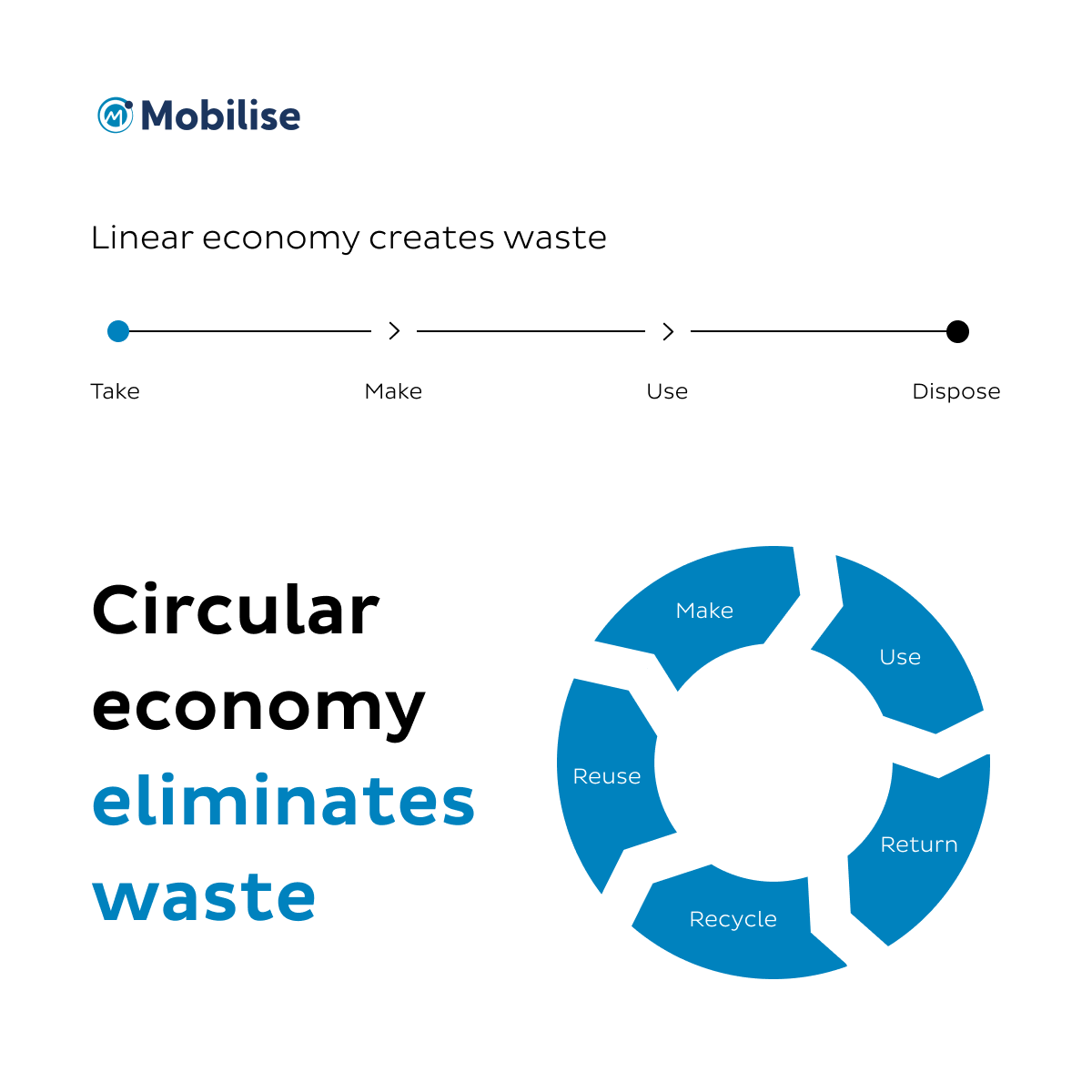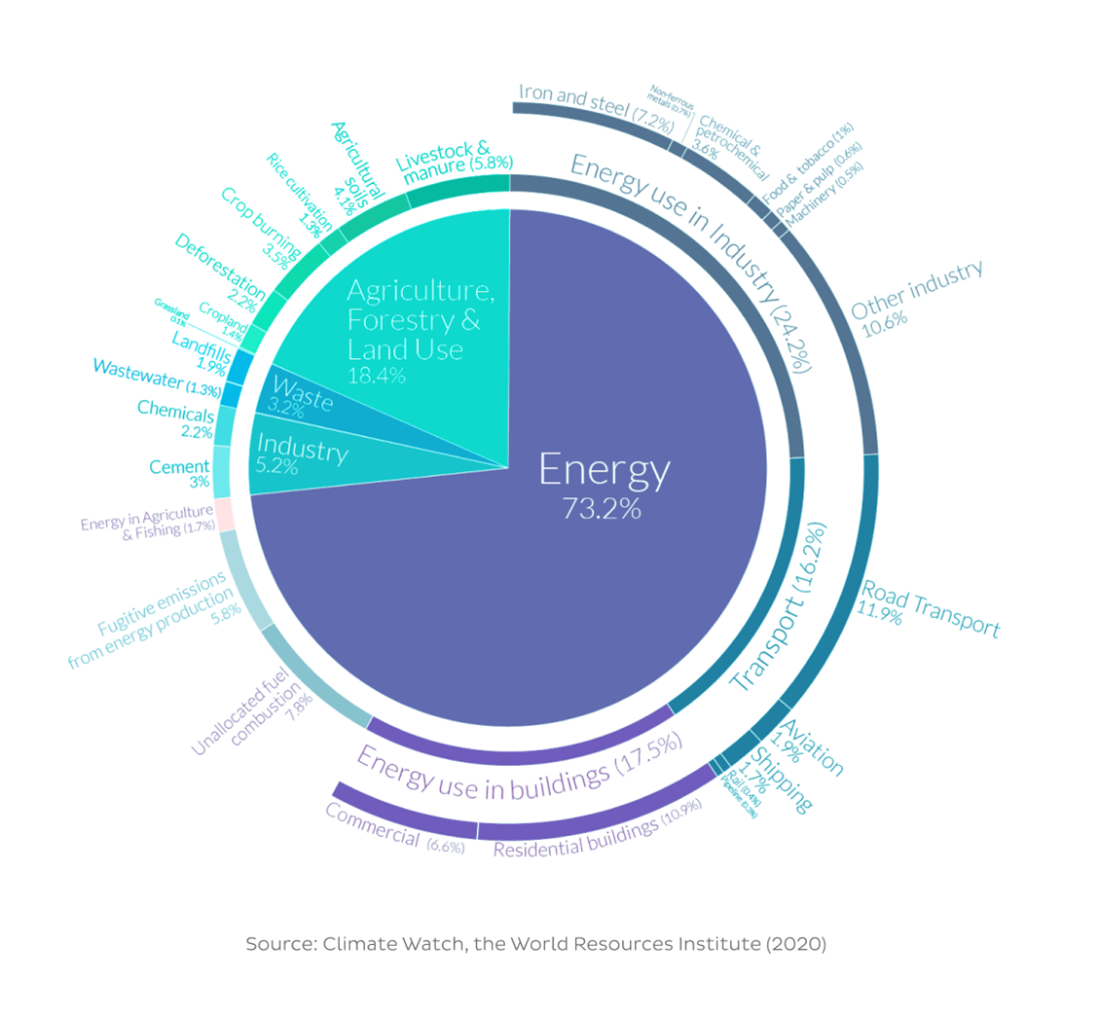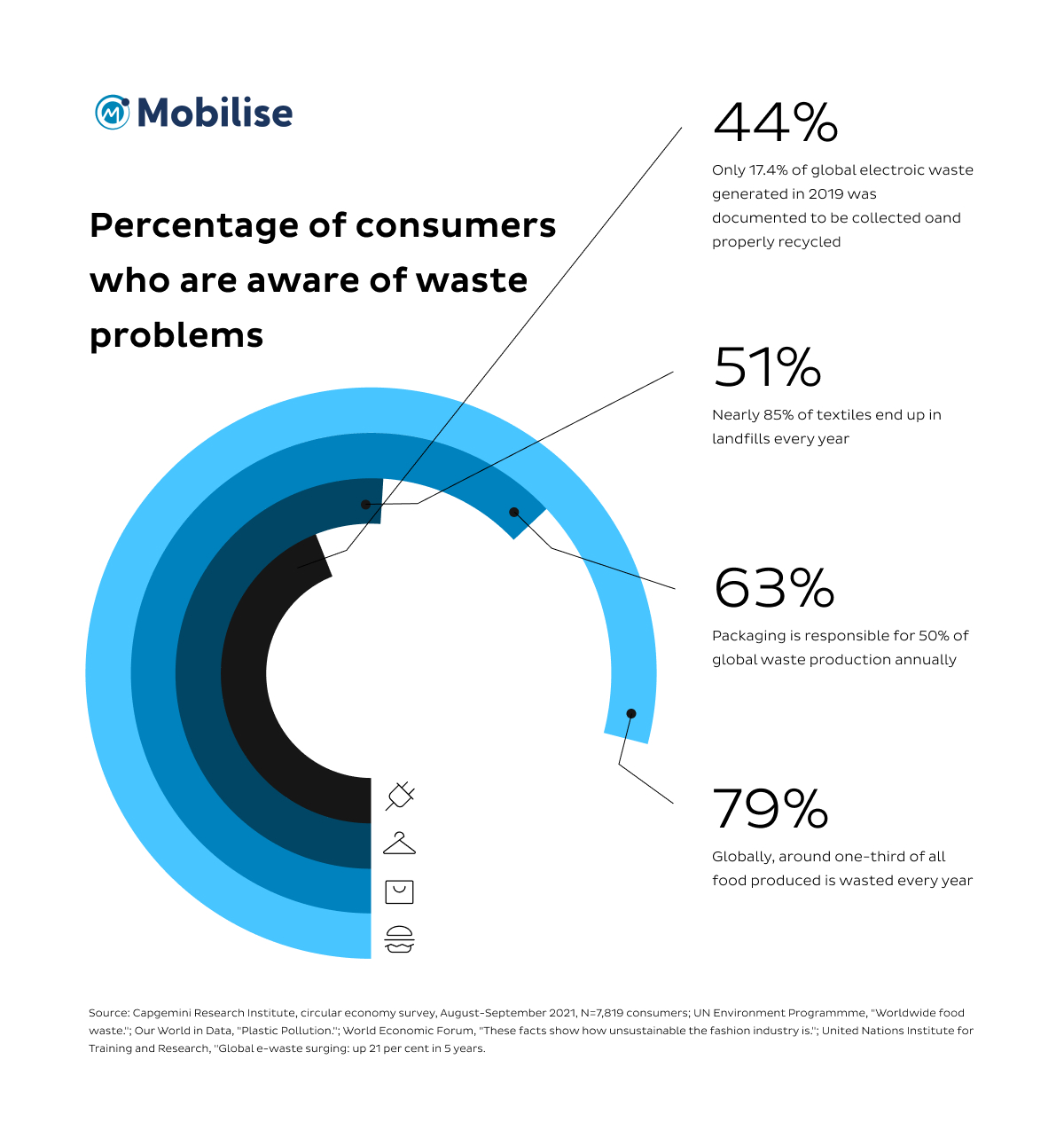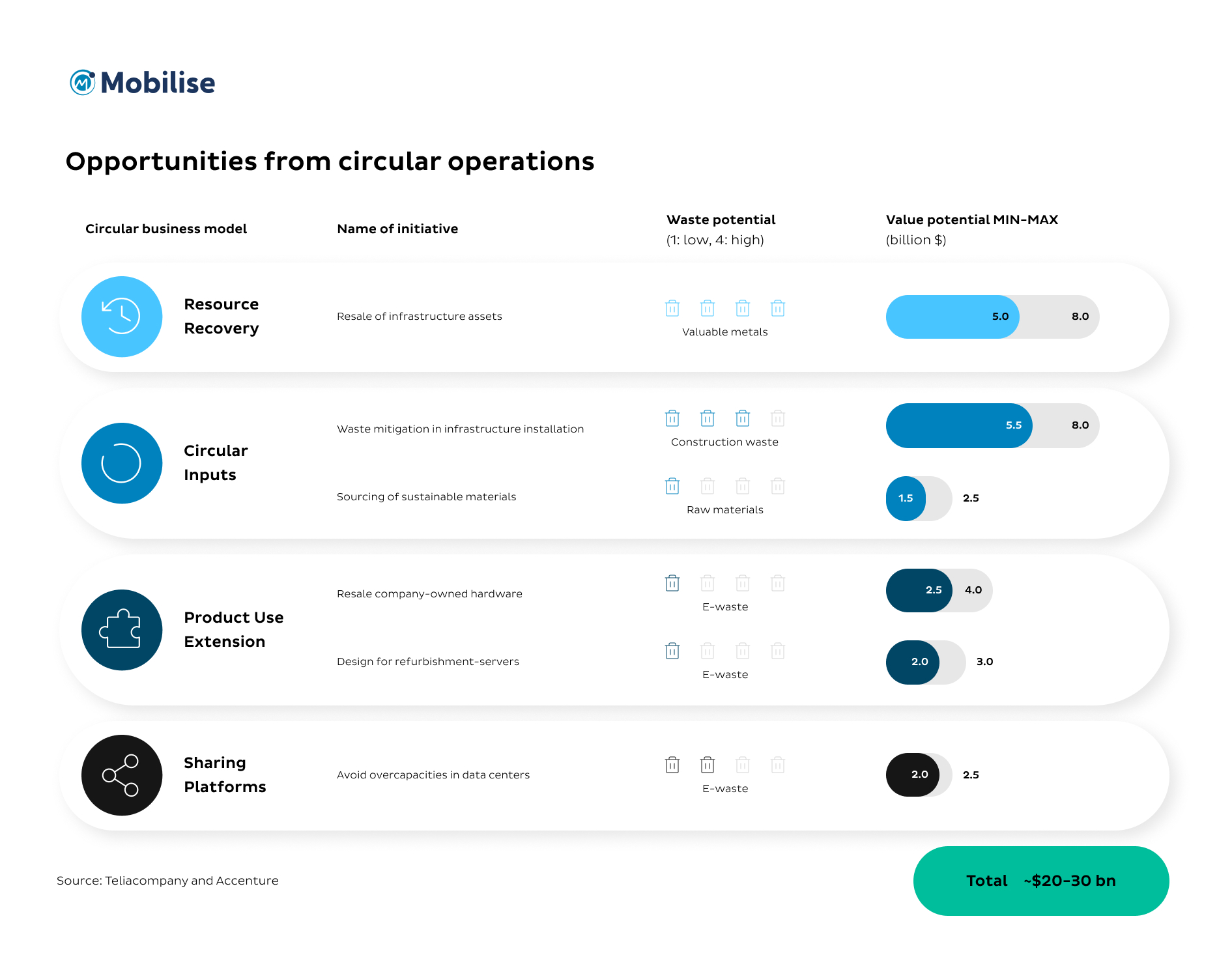Consumers are eager to adopt sustainable activities. This includes reducing consumption, reusing items, using things for longer periods of time and recycling. There is a high level of consumer knowledge surrounding excess waste. Along with implementing some circular practices themselves, it restricts most consumers to the post-use phase of the product lifecycle. But consumers are eager to promote and support corporations that use a circular economy in telecom, and will reward them.
Circular Economy—the concept
The Circular Economy concept is a common concept in the telecoms industry. It emphasises the preservation of value in products, materials, and resources for as long as possible, to extend the product life cycle and minimise waste. According to TXO, 90% of operators believe that the circular economy is important to their organisation.
Masses of telecom devices become electronic waste — mobile phones, SIM cards, wires, batteries, and other equipment are often in service for just a few years. The glass that makes up a device’s screen, however, can take a million years to break down. Many of a device’s other components contain heavy metals including lead, mercury, and cadmium, which, if mishandled, can pollute the environment.
To combat this issue, it’s crucial for our industry to take a more circular approach. Many big vendors have already announced measures to encourage recycling — for example, Vodafone is 18 months into its circularity program, which aims to repair, resell and refurbish old electronics to eliminate waste and reduce CO2 emissions.
Sustainability in the telecoms industry is something that all operators have a part in.
Linear vs Circular economy in telecom

The linear economy model typically deals with raw materials inefficiently since the emphasis was not on the conservation of materials and products. It promotes the processing and usage of raw materials in a single-use fashion and then discarded as waste.
Compared to a linear economy, a circular economy in telecom should eliminate and minimise waste at every step of the journey, creating closed-loop systems.
If we continue to use a linear economy, by 2050, the world’s demand for resources could almost triple, depleting the planet’s natural resources by over 400%. And this could prove to be more dangerous to not only all industries, but the world.
Dematerialisation of components
In research conducted by ABI Research, 4.5 billion plastic SIM cards were produced worldwide in 2020 to connect mobile devices to the network, in a plastic and carbon-intensive manufacturing process. Although many telcos have partly dematerialised their SIM card offerings by reducing their size and packaging, the rise of the embedded SIM, or eSIM, could eliminate the need for physical components.

The carbon footprint generated from the production and distribution of SIM cards is typically very high. In 2012, the ICMA estimated that 2 billion SIM cards are shipped annually. Thus, the SIM card industry contributed about 2,000,000,000×35g CO2e or 70,000 tons. Following the same formula and applying more recent data, the estimated carbon footprint of SIM cards in 2020 contributed about 4,500,000,000×35g CO2e or 157,500 tons.
Consumer awareness

According to Capgemini, consumers are concerned about the issues of resource depletion and waste, especially food and plastic waste. In 2019, research found that only 17.4% of global electronic waste was documented to be collected and properly recycled.
This highlights the issue that it’s not just down to consumers to be conscious of how they dispose of their products. But also corporations. Especially in the telecom industry.
Digital customers and their loyalty towards a brand depends on the brand’s transparency and values. They will spend more and be more loyal to a brand with a clear, genuine (and green) purpose. According to the 2020 Consumer Culture Report from 5W Public Relations, 83% of millennials want brands to align with their values. Additionally, 94% of customers consider how much info a brand reveals about itself to be important, emphasising the importance of brand transparency.
Current challenges involved in implementing a circular economy in telecom
Even though implementing a circular strategy has many obvious advantages, KPMG has identified the major challenges that the telecom sector must overcome.
A majority of the industry is committed to reducing its carbon emissions. And there is a unanimous agreement on the need to limit climate effects. Two-thirds of mobile network operators, by revenue, have made a commitment to drastically reduce their supply chain and carbon emissions in the next decade.
Economic challenges
Telco operators’ efforts to achieve circularity are hampered by multiple financial challenges. These include restricted access to capital, a lack of investment incentives, high startup costs, and a poor rate of return on investment. Circularity is further limited by increased prices for sustainable materials used across the telecom value chain.
Complex supply chain
Circularity generally requires considerable collaboration from companies throughout the telecom value chain. For example, operators are expected to interact with third parties within the chain to improve waste reduction and waste separation in order to maximise reuse and recycling rates, such as by reusing parts. Besides this, there is a significant amount of reverse logistics that must be handled in order to successfully accomplish circularity.
Lack of knowledge
One of the biggest challenges in the industry is the lack of knowledge. Knowledge about an integrated and holistic approach to collaboration and specific circular practices. A significant concern in developing a circular economy in telecom is, for example, product design or production of modular devices or goods that permit individual repair or replacement.
Consumer behaviour
Consumers’ understanding of and desire to be proactive in reducing their environmental impact is highly diverse and mostly determined by personal preferences and choices. Their decision to adopt circular economy efforts is also influenced by their lack of understanding of how to recycle and reuse technology and their concerns about data protection and privacy.
What can telcos do?
Even if there are endeavours towards a circular economy in telecom, it is essential for all stakeholders that efforts are increased. Consumers will pay much more for brands that are sustainable and environmentally conscious as they become more aware of how their decisions affect the environment. This is a massive opportunity that shouldn’t be passed up in a sector that deals heavily with consumers.
Service Providers (SPs) will need to evaluate existing business models in order to incorporate circularity within their operations. Not only that but to strive to source circular and sustainable alternatives to existing resources. This can later maximise the efficiency of their products and services and reduce overall costs.
Marketing sustainability and circularity
The power of marketing can be leveraged to promote a greener telco. Create enticing storylines about how consumers can contribute to recycling or reusing items more easily. Circular economy efforts can be promoted by using fact-based communications. And can be about the environmental, social, and economic advantages of circular buying. Tools can be created to raise an understanding of how consumers’ choices impact the environment.

AI
Artificial Intelligence (AI) offers telecommunications and SPs countless chances to reduce costs and increase energy efficiency. SPs can employ AI for effective data analysis, processing, and translation into actionable insights. It makes it possible to analyse massive amounts of data from various sources fast and effectively. As a result, quick automated decision-making to support resource management and allocation may be made possible.
eSIM
Support for eSIM has the potential to cut SPs’ expenses by an astounding 80%. Without having to wait for the delivery of a physical SIM card, operators can instantly onboard their customers thanks to remote SIM provisioning.
Customers can install and activate an eSIM through the app without the hassle of paperwork. Users only need to tap once to activate their SIM profile securely and link their devices to the network. Not only does this streamline customer onboarding, but it also completely dematerialises SIM cards. Reducing the plastic waste and carbon emissions associated with SIM card manufacturing and transportation.
RECOMMENDED READING
Conclusion
A circular economy in telecom is the most obvious solution for telcos to operate more sustainably. And doing so will create more benefits and advantages compared to refusing to change.
SPs and operators have a role to play in reducing their waste and emissions. And consumers are more than willing to support a business that plays its part.
Sustainability is now not an option anymore, it’s a necessity. For both the future of the telecoms industry and the planet.



